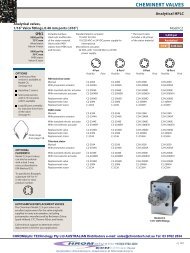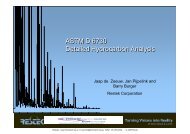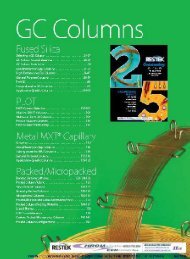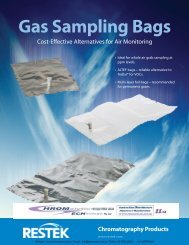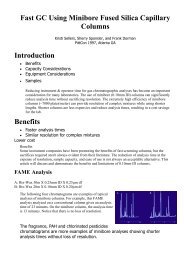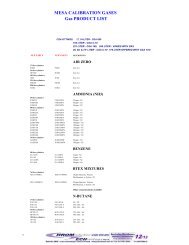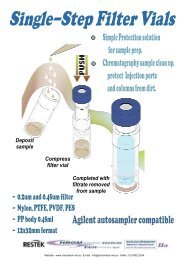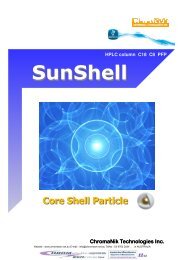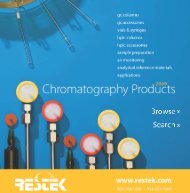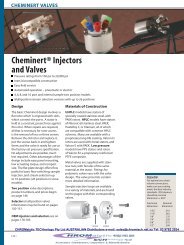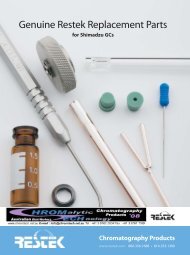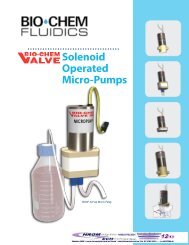Sunrise C18 Sunrise C18-SAC
Sunrise C18 Sunrise C18-SAC
Sunrise C18 Sunrise C18-SAC
Create successful ePaper yourself
Turn your PDF publications into a flip-book with our unique Google optimized e-Paper software.
<strong>Sunrise</strong> <strong>C18</strong> and <strong>C18</strong>-<strong>SAC</strong>Silanol Activity Controlled <strong>C18</strong> HPLC Column◆ <strong>Sunrise</strong> series create an unique separation✻ Effectiveness of silanol activity control: Comparison between <strong>Sunrise</strong><strong>C18</strong> and <strong>C18</strong>-<strong>SAC</strong><strong>Sunrise</strong> <strong>C18</strong> is the so-called fully end-capped <strong>C18</strong>column. It shows the same separation behavior as aconventional <strong>C18</strong> column.On the other hand, <strong>Sunrise</strong> <strong>C18</strong>-<strong>SAC</strong> showshydrogen bond and ion-exchange interactionsbased on a residual silanol on the silica support inaddition to reversed-phase separation. For example<strong>Sunrise</strong> <strong>C18</strong> column separates a basic compoundsimilarly as a conventional <strong>C18</strong>, while <strong>Sunrise</strong> <strong>C18</strong>-<strong>SAC</strong> makes retention of a basic compound belarge because an ion-exchange interaction worksalthough a non-ionic compound shows the almostsame retention on both <strong>Sunrise</strong> <strong>C18</strong> and <strong>C18</strong>-<strong>SAC</strong>.Furthermore, <strong>Sunrise</strong> <strong>C18</strong>-<strong>SAC</strong> shows large retentionfor a polar compound such as caffeine.■ comparison of selectivity for basic compoundsA) <strong>Sunrise</strong> <strong>C18</strong>4321B) <strong>Sunrise</strong> <strong>C18</strong>-<strong>SAC</strong>1 25Column size: 4.6x150 mmMobile phase:50/50=CH 3 CN/20 mM PBS pH4.5Flow rate: 1.0 mL/minTemperature: 40 ºCSample: 1 = uracil2 = propranolol53 = nortriptyline4 = amitriptyline5 = toluene34■ comparison of peak shape and retentionA) <strong>Sunrise</strong> <strong>C18</strong>1B) <strong>Sunrise</strong> <strong>C18</strong>-<strong>SAC</strong>12Column size: 4.6x150 mmMobile phase:10/90=CH 3 CN/20mM H 3 PO 4Flow rate: 1.0 mL/minSample: 1 = 8-quinolinol (oxine)2 = caffeine20 5 10 15 20retention time / min0 2 4 6 8 10 12 14 16 18 20 22retention time / min✻ <strong>C18</strong> with both silanol activity control and full end-capping is effective inseparation of polar compounds.<strong>Sunrise</strong> <strong>C18</strong> is bonded with octadecylsilane on puresilica gel (average pore size: 12nm, specific surfacearea: 340m 2 /g), and end-capped after silanolactivity control. Final carbon content of <strong>Sunrise</strong> <strong>C18</strong>is 15%.Ligand density of <strong>Sunrise</strong> <strong>C18</strong> is intentionally ratherlow and uniformity of ligands is high, so that it showsenough retention, even if a mobile phase with alow organic solvent content is used, and goodpeak shape for a polar compound.■ Separation of organic acid (<strong>Sunrise</strong> <strong>C18</strong>)■ Separation of nucleic acid bases (<strong>Sunrise</strong> <strong>C18</strong>)1 23Column size: 4.6x150 mmMobile phase:2/98=CH 3 CN/0.1% phosphoric acidFlow rate: 1.0 mL/minTemperature: 40 °CSample:1 = formic acid2 = acetic acid3 = propionic acid12Column size: 4.6x150 mmMobile phase: 20mM PBS (pH4.5)Flow rate: 1.0 mL/minTemperature: 40 °CSample:3 1 = cytosine42 = uracil3 = thymidine4 = thymine0 1 2 3 4 5 6 7 8 9 10 11 12 0 1 2 3 4 5 6 7 8 9retention time / minretention time / min



